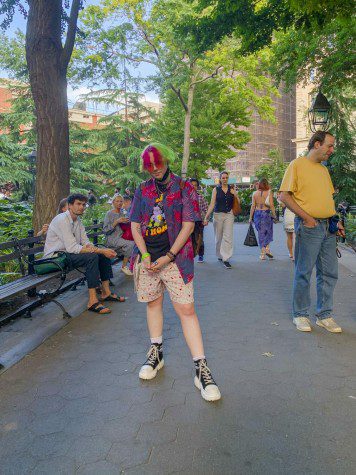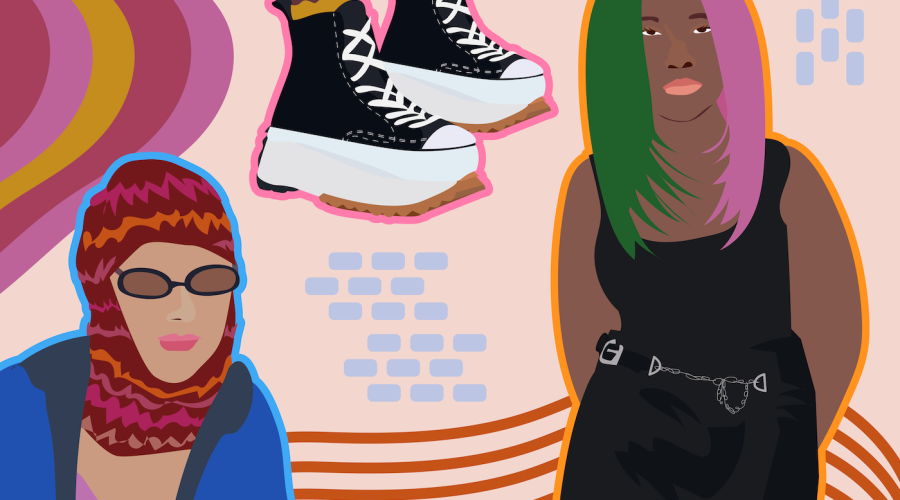White Converse with a red and blue stripe: That’s the first trend I remember. Everyone would wear them with black leggings and a sweater. In the seventh grade, I thought wearing the same shoes and clothes as everyone else was the ultimate style achievement. I saved up for months, deciding whether I wanted the high-tops or low-tops.
I remember the moment everyone stopped wearing those shoes too — when we seemingly all decided they were too basic. But I kept wearing those sneakers until the soles ripped away, only discarding them once they were past the point of use.
Our generation’s styles and tastes, our “ins” and “outs,” have changed as quickly as culture progresses. In March 2020, at the start of quarantine, TikTok garnered immense popularity. It became a constant presence in our lives at a time when we were all longing for the interpersonal connections of our pre-pandemic lives. The platform allows for short-form videos to be consumed at a pace faster than any other social media platform — much like the current pace at which oddly specific clothing styles are consumed.
Thus came the phenomenon of microtrends, an allusion to how quickly the trend enters and leaves the fashion cycle. In an article published by Vox this February, writer Rebecca Jennings argues that trends, such as twee, regency-core, balaclavas, soft-grunge and avant-apocalypse, are all part of a larger trend she calls “TikTok couture,” a series of microtrends that all originated, lived and died on TikTok.
De-programming the TikTok algorithm from your personal style isn’t as easy as it sounds. However, from a simple walk in Washington Square Park, one can see that people care about what they wear and what they buy, thrift, gift and find.
Recently, on a September afternoon, a friend and I decided to channel our inner Davis Burleson, the host of the popular TikTok series “What’s Poppin.” He’s famous for walking around the park asking, “How much does your outfit cost from head to toe? Let’s talk about it.”
“What’s Poppin” gives its viewers a glimpse of the high-end fashion of New York City, as some outfits total far into thousands of dollars. In my own experience, I’ve seen people in the park dripping in head-to-toe designer, or wearing absolutely nothing. I wanted one question answered: What do people with great personal style have to say about the cost of their outfits?
We spoke to four people, initially picking those with distinct senses of style and outward expressions that screamed “I have something to say.” It seemed that no one had a problem talking about themselves or their clothes. One even sought us out, complimenting my friend’s shoes.
“Hold on a minute,” I said to the first person. “We have a question for you.”
A huge smile grew on their face as they stuck out their hand to shake ours, introducing themselves as Pink Gibbs. Their statement pieces were a black denim skirt, pink piercings, pink hair and pink shoes. Everything they wore was gifted, thrifted or found, except their shoes, which they told us were around $300. For Gibbs, style is about gender expression and is a vital component to them as a nonbinary person.
Gibbs is a musician, a creative, and as they put it, “I also work at fucking Home Depot.”

(Ella Anderson for WSN)

(Ella Anderson for WSN)
Ally Szczepanik was sitting on a rainbow crochet blanket, wearing an eclectic outfit and basking in the sunlight. A junior fashion student studying in Ohio, Szczepanik is in the city for an internship this semester. She had designed and made the pants she wore, and everything else was either secondhand or self-created. What is self-expression to her?
“It can be anything,” Szczepanik said.
Her style is what excites her. It’s how she interacts with others and communicates her inner self, or vibe, as she said.
August Apostolakis-Beatty was walking with their partner in the park, exuding pure coolness dressed in vibrant hues that seamlessly matched their split-dyed pink and neon green hair. Their style seemed to be mismatched, not able to be categorized into a specific trend or micro-trend, but genuinely authentic. Apostolakis-Beatty’s shoes were the most expensive element of their outfit.

(Ella Anderson for WSN)
“I don’t think it takes money to make a good outfit,” they said. “It’s about finding something you like.”
They defined self-expression as “anything you put care into.” As an art student, that meant their work, clothes and hair.
The last woman we spoke to declined to give us her name or allow us to take a photo. However, she was undeniably expressive while lacking color. She wore a pair of simple sandals, a 10-year-old black-and-white dress from H&M, and a thin gray shawl placed lightly around her neck and shoulders. When we approached her, her head was pointed up towards the sunlight. She had just taken a deep inhale while her eyes were closed. She then serenely opened them.
She was shocked when we approached her. When we asked the woman what personal style meant to her, she talked about health. She pointed at our shoes and asked in a thick Russian accent, “Can I tell you something you might not like?” My friend and I looked briefly at one another before saying yes, presuming that she would say our outfits weren’t to her liking or something in that realm. Instead, she told us our shoes were not healthy.
According to her, our feet couldn’t breathe. She said that in Russia, they all wear open-toed shoes in the summer, while people in New York wear boots year-round. She never buys anything that’s not cotton, and she prioritizes well-being and comfort when it comes to her style. As she talked about fungus and bacteria that can be caused by frequent closed-toed shoes, it felt as though she was interviewing us.
She told me she liked my style, but that her daughter would hate it. Her daughter is in her 30s now and never liked her mom’s style. Even now, according to the woman, her daughter said the monochrome dress she was currently wearing resembled a trash bag. And so began a running joke between the two that her clothes embodied either “Good trash bag, bad trash bag.”
The woman hasn’t bought clothes in ages, even healthy shoes. She assured us that she still always wants to look nice. Rather than through clothing, she chooses to express herself through her art. While her daughter would say she has no style, we thought she did.
Mid-sentence, she paused to inform us that if we Googled her, we’d find her. There’s no way to ever really know if she was telling the truth, but something — maybe her eccentric personality, unexpected tangents or just the general vibe — made me believe her.
The accidental theme of the park excursion was shoes, reminding me of the pairs that I’d owned throughout my life. My old Converse represented a need to belong and stuck with me until they broke apart. I thought of the Dr. Martens I bought when I first moved to the city, and how I wore them nearly every day for a year. Recently, I started wearing a pair of Dansko clogs that a friend bought secondhand for me. Walking around in them, I feel like myself, just like everyone in the park who carried themselves with confidence and an essence of personal flair. Personal style is prominent in the park.
Contact Ella W. Anderson at [email protected].
























































































































































